Newspapers and Women Empowerment in Kanthapura
The Role of Women and Newspapers in the Indian National Movement, as Represented in Kanthapura

Raja Rao’s Kanthapura captures a crucial moment in the history of modern India : the Indian freedom movement through the rich regional colours, social milieu and an emphatic yet incisive exploration of the world of Kanthapura. With a novel such as this, the immediate historical context becomes as important as the text in view of their dialectical relation between each other, especially considering the fact that the novel was published in 1938 when India was yet to gain independence. One way of understanding this relationship is by analysing the use of newspapers and their role in the national movement as presented in the novel. The role of newspaper in the national movement in Kanthapura may be fruitfully explored by doing so along three cardinal points: the text, the context and the craft. The essay strives to delineate the matter along these planes.
Insofar as the narrative is concerned, newspapers play a significant role in in both furthering the plot of Kanthapura as well as in influencing the characters in a novel which is strikingly reticent in it characterization. The astute and well-informed character of Rangamma could never have been complete without the Tai-nadu, Vishwa-Karnataka, Deshbandhu and Jayabharatha that she subscribes. It is through these newspapers that she becomes cognizant of facts like the evolution of man and the current political scenario.
Newspapers had functioned as a crucial link between the city where the national movement was directed and the country whose masses provided the momentum for the movement. The newspapers not only created a connection between the two but also helped counter the apathy/ antipathy of the landlords and high caste priests with vested interest who sought to legitimise the superiority of their opinions through their socio-economic status. In this regard, the remark made by the narrator while comparing Rangamma and the brahmin priest Bhatta is pregnant with a socio-political import : ” Rangamma was no village kid like us, and she could hold a word-for-word fight with Bhatta.
Midway through the novel, the news of Moorthy’s arrest and the subsequent mobilization of people is made through the newspapers thereby significantly influencing further course of action. The role of newspapers in informing the public and criticising the government becomes crucial in this context. Indeed, the episode mimics the role played by newspapers like Kesari and Amrita Bazar Patrika during the arrest of leaders like Bal Gangadhar Tilak. Thus, whe see that newspapers not only shaped the people for an active involvement in the national movement but also contributed towards intensifing it by facilitating the movement to leverage its mass base.
The backdrop of the national movement in which newspapers are published demands a contextual exploration. The role of local/regional newspaper in this highly regional novel is reflective of how newspapers linked the corners with the centre and functioned as a platform through which the coordinates of mass movements ran. This is clearly felt when Ratna mobilizes the masses by taking charge of Congress papers after Moorthy’s arrest. The subversive role of regional newspapers had been earlier recognized by the British in the form of the 1878 Vernacular Press Act , infamously known as “the gagging act”.
As with the India of early twentieth century, women have been effective torch bearers of the political struggle in Kanthapura. Newspapers, both in the case of Rangamma and Ratna ( as in case of numerous women in the national struggle) become an agent of empowerment, a source of political “shakti” , with a shift from the erstwhile regio-cultural connotations. The agency in knowing and acting upon that knowledge as provided by the newspapers expands the consciousness and serves as a source of empowerment. Indeed, the expansive freedom of thought as exhibited in Rangmma’s case is a crucial precursor to political freedom and the newspapers in furthering the former heralded the latter. In empowering people to take charge of their sense of awareness of the self, thereby allowing to govern their collective actions in a productive manner, newspapers also embodied the second meaning of Swaraj as expounded by Gandhi in Hind Swaraj ie. rule over the self which was to result in self rule.
An important question one may pose while dealing with the newspapers is what does it mean for the people in the novel? Newspapers not only become a disseminator of the movement but also an agent of empowerment by encouraging literacy as a valuable trait to be acquired, thus contributing to the empowerment of people who were behind the nation in the making.
Also, the newspapers acquire a symbolic significance above and beyond what it means under normal circumstances. The very idea of newspaper then becomes different from what it meant in the West, especially in the context of vast illiteracy. The medium becomes the message, for the Blue papers and the morning dailies are viewed not just as a form of media but an agent of national awakening. Reading one suddenly becomes a collective experience, a revolutionary act for the “dumb millions” as expressed by Rangè Gowda:
” Rangamma, I do not know how to read, but my little mosquito goes to school and, if he is worth the milk he has drunk, he will read it out to us”
Interestingly, attack on the toddy shops thus acquire both literal and symbolic significance in that it is not only an attack on the licence-based colonial economy which capitalized on people’s dependencies but also an attack on a system of officially sanctioned narratives which rendered them insensate in drunken stupor. Newspapers, on a symbolic level, become pivotal in countering the ideological state apparatus of the colonial state which was deployed to make the masses drunk with its official narratives.
The role of newspapers vis-a-vis the national movement, apart from being explored through the content and the context may also be analysed by keeping in view Raja Rao’s craft. The narrative of Kanthapura is a creative documentation of the eventful socio-political life of the town as reported by Achakka. As a novel pre-eminently engaged with myths and myth-making, one may detect a parallel function which the newspapers undertake in the novel by mimicking the novel itself. Whereas the narrative explores the socio-cultural sthala-purana of Kanthapura, the construction of its political sthala-pruana is informed by the newspapers. The reworking of myths is witnessed in the masterly incorporation of Gandi while describing the pantheon of Gods who’ve incarnated themselves to destroy evil in their respective yugas. Whereas the content for the former is derived from religio-cultural myths, the material for the latter was greatly informed by and disseminated through the newspapers which provide a common reference point for the Harikatha man and his listeners, thereby performing the singular function of bridging the gap between the political leadership and the rural masses on which the mass movement is based. Thus, in tandem with Raja Rao’s use of the regional myths, the newspapers provide much matter and medium for the modern sthala Purana and a neo-Harikatha of Indian freedom movement.
Works Cited and Referred
1. Rao, Raja – Kanthapura , Oxford University Press
2. Gandhi, Mahatma – Hind Swaraj or Indian Home Rule, Rajpal Publishing
3.. Chandra, Bipan – India’s Struggle for Independence, Penguin Publication
4. Shahane, A. Vasant – Fiction and Reality in Raja Rao, Journal of South Asian Literature
5. Mondal, Anshuman, The Emblematics of Gender and Sexuality in Indian Nationalist Discourse, Modern Asian Studies
6. Narayan Iqbal, Kaushik Asha – Charisma Ideology and Politics : Gandhi in Indo- Anglian Novels , The Indian Journal of Political Science





I wrote a paper based on the insights of your essay on Kanthapura. Thank you so much.